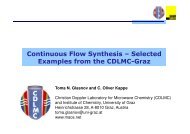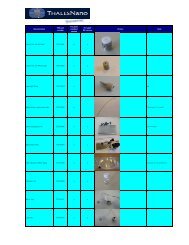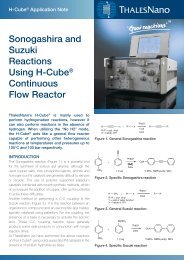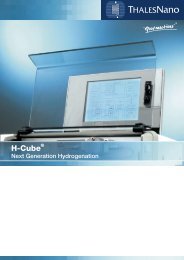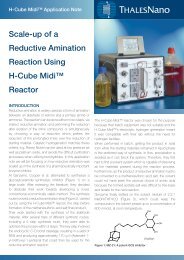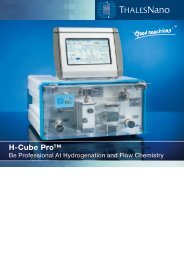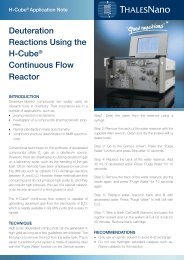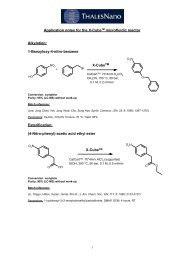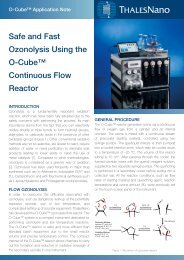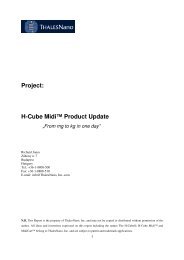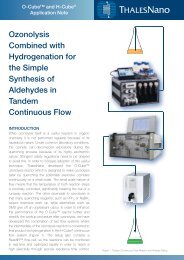H-Cube® Application Note - ThalesNano
H-Cube® Application Note - ThalesNano
H-Cube® Application Note - ThalesNano
You also want an ePaper? Increase the reach of your titles
YUMPU automatically turns print PDFs into web optimized ePapers that Google loves.
H-Cube ® <strong>Application</strong> <strong>Note</strong><br />
Deprotection<br />
Reactions Using<br />
the H-Cube ®<br />
Continuous Flow<br />
Reactor<br />
INTRODUCTION<br />
Protecting groups play a central role in modern organic<br />
synthesis. The benzyl groups and benzyl carbamate<br />
or Cbz groups are some of the most commonly used<br />
protecting groups and play a central role in the protection<br />
of alcohols, carboxylic acids, and amines. The benzyl and<br />
benzyl carbamate groups are removed using catalytic<br />
hydrogenation using elevated temperature. The H-Cube ®<br />
is able to remove benzyl groups from amines, acids,<br />
or alcohols very effi ciently in one pass through a 10%<br />
Pd/C CatCart ® . This application note gives examples of<br />
deprotection reactions performed on the H-Cube ® from<br />
the recent articles.<br />
O-BENZYL DEPROTECTION<br />
Parameter Optimization<br />
To fi nd the optimal parameters of catalytic hydrogenolysis,<br />
the O-debenzylation of O-benzyl protected N-Boctyrosine<br />
(Figure 1.) was investigated by Knudsen et<br />
al1 . A series of experiments over 10% Pd/C catalyst<br />
in EtOH:EtOAc (1:1) solvent were performed to probe<br />
the effects of fl ow rate, temperature and concentration<br />
using an automated hydrogenation platform. Results<br />
showed a faster catalyst deactivation rate with increasing<br />
concentration and fl ow rate, but at higher temperature<br />
they found dramatically increased conversion rates. At<br />
room temperature the conversion rate was half of that<br />
observed at 60°C.<br />
Figure 1: Debenzylation of O-benzyl protected N-Boc-tyrosine<br />
100% conversion was reached, when the concentration<br />
of reactant solution was 0.1 M, the applied temperature<br />
was 60ºC, and the fl ow rate was 1 mL/min.<br />
Catalyst Reactivation<br />
As the catalyst can be poisoned and deactivated over a<br />
long reaction time, catalyst reactivation is a key factor in<br />
heterogeneous catalysis. To increase the catalyst lifetime<br />
the following reactions were performed. Equal amount of<br />
reactant was introduced to the system in two different<br />
ways: continuously and through repeated injections of<br />
small amounts. With the injection method, there was a<br />
short period of time between each injection where the<br />
solvent regenerated the catalyst by washing off any<br />
adsorbed material. This short washing period generated<br />
higher conversion rates compared to continuous<br />
pumping the material through the catalyst.
H-Cube ® <strong>Application</strong> <strong>Note</strong><br />
N-CBZ DEPROTECTION<br />
Reaction Optimization and Library Synthesis<br />
An N-deprotection reaction was also optimized by<br />
Knudsen and co-workers 1 with the reaction shown in<br />
Figure 2. After fi nding the optimized reaction conditions,<br />
such as elevated temperature of 80°C, pressure of 1 bar,<br />
and solvent concentration of 0.05 M using 10% Pd/C<br />
as catalyst, a small library of N-protected compounds,<br />
including dipeptide and amino acid derivates, was<br />
successfully hydrogenated. As seen in the previous<br />
reaction series, the temperature also had a signifi cant<br />
effect on the conversion rate. The observed yield of<br />
isolated products were high in each case and are<br />
displayed in Table 1.<br />
Figure 2: Deprotection of ε-[N-Cbz] lysine tert-butyl ester<br />
Substrate<br />
Cbz-Pro-OMe<br />
Cbz-Piperazine<br />
Cbz-Asp(OMe)-OMe<br />
Cbz-(OBn)Tyr-OMe<br />
Cbz-Ser-OMe<br />
Boc-( N-Cbz)-Lys-O(Naph)<br />
Cbz-Thr-Tyr(O-t-Bu)-O-t-Bu Cbz-Pro-tetrazole<br />
Conversion [%]<br />
Table 1: Deprotection of eight N-Cbz protected compounds<br />
When Cbz-(OBn)Tyr-OMe (Table 1, line 4.) was<br />
introduced to the automated H-Cube ® system, selective<br />
Cbz deprotection was observed and the desired product<br />
was isolated in 83% yield.<br />
Part of New Synthesis Pathway<br />
A practical and safe synthesis of (S)-pyrrolidine-2-yl-<br />
1H-tetrazole was developed by Franckevicius and coworkers<br />
2 to prepare a catalyst which can be used in<br />
Mannich and aldol reactions leading to high yields. The<br />
synthetic steps eliminate the generation of hazardous<br />
materials such as, ammonium azide and the use of nonvolatile<br />
solvent.<br />
99<br />
99<br />
99<br />
97<br />
98<br />
95<br />
99<br />
99<br />
Yield [%]<br />
99<br />
80<br />
77<br />
83<br />
82<br />
86<br />
96<br />
99<br />
In the fi rst synthetic step a protected pyrrolidine derivate<br />
was synthesized, which was subsequently transformed<br />
to the tetrazole derivate of the Cbz protected pyrrolidine<br />
with sodium azide. Overall yield was 92%.<br />
In the last step, Cbz deprotection (Figure 3.) was<br />
achieved by the H-Cube ® using a volatile solution mixture<br />
of EtOAc:EtOH:AcOH = 1:1:1. The method dramatically<br />
reduces the reaction time. In batch when 9:1 acetic<br />
acid:water solvent mixture was used, the reaction time<br />
and time consuming work-up extended the total reaction<br />
time to 3 days. While in fl ow mode 3 g of desired<br />
compound was synthesized in 3.5 hours. The reaction<br />
seen in Figure 4. was performed using full hydrogen<br />
mode at a fl ow rate of 1 mL/min, temperature of 80°C<br />
and a starting material concentration of 0.05 M. 10%<br />
Pd/C was used as catalyst. Working-up the reaction<br />
was carried out by simple evaporation of the solvent.<br />
Figure 3: Deprotection step of (S)-5-pyrrolidin-2-yl-1H-tetrazole<br />
synthesis<br />
Yield of the deprotection was 98% and resulted in an<br />
overall yield of 90% for the total synthesis.<br />
O-DEBENZYLATION<br />
Part of New Reaction Pathway<br />
A debenzylation step was performed by Desai and Kappe<br />
to produce dihydropyrimidines (DHPM) C5 carboxylic<br />
acids 3 . The synthesis of the acids can be readily achieved<br />
by hydrogenolysis of the corresponding benzyl esters.<br />
The previously reported batch reaction resulted in high<br />
yields and used an external hydrogen gas source, while<br />
when the H-Cube ® was used with 10% Pd/C catalyst<br />
there was no need for a gas cylinder. The reaction<br />
scheme and the isolated yield values obtained are seen<br />
in Figure 4. and Table 2. Under these circumstances in<br />
continuous fl ow („CF”) mode 80 - 95% isolated yields of<br />
the DHPMs acids were obtained.
Figure 4: Hydrogenation of DHPM C5 Benzyl Esters<br />
Yields were also obtained from the deprotection reaction<br />
of DHPM esters under other conditions. Namely, room<br />
temperature catalytic transfer hydrogenation („rt”) in<br />
ammonium formate, and microwave-assisted transfer<br />
hydrogenation („MW”) in ammonium formate 4 . When<br />
room temperature hydrogenation was applied, reactions<br />
took 8-10 h reaction time and only 56 - 66% yields were<br />
obtained. The microwave assisted method did not result<br />
in signifi cant enhancement of the yields. The obtained<br />
values were between 53 - 62%, but the reaction times<br />
were reduced to minutes.<br />
R1 R1 R2 R2 R3 R3 H H<br />
Me<br />
H H Ph<br />
Me H Me<br />
H 4-Me Me<br />
Conditions<br />
rt<br />
MW<br />
CF<br />
rt<br />
MW<br />
CF<br />
rt<br />
MW<br />
CF<br />
rt<br />
MW<br />
CF<br />
Yield [%]<br />
66 66<br />
62<br />
95<br />
65<br />
60<br />
80<br />
57<br />
55<br />
85<br />
56<br />
53<br />
85<br />
Table 2: Isolated yield values of hydrogenation of DHPM C5 benzyl<br />
esters<br />
Compared to the batch and microwave techniques,<br />
H-Cube ® gave yields between 80 – 95%. The major<br />
advantage as they emphasized that these excellent<br />
yields were obtained after a simple evaporation thus this<br />
easy work-up makes this method an attractive solution<br />
for automated library generation.<br />
H-Cube ® <strong>Application</strong> <strong>Note</strong><br />
MULTIDEBENZYLATION AND DOUBLE<br />
BOND REDUCTION<br />
A debenzylation in conjunction with a double bond<br />
reduction reaction plays an important role in the synthesis<br />
of polyhydroxylated oxamacrolides, as reported by Matos<br />
and Murphy 5 in a multistep synthesis.<br />
In the previous step, before the reduction, a mixture<br />
of macrolactones was produced, separated and then<br />
introduced into the H-Cube ® . Deprotection of the four<br />
benzyl groups and the saturation of the double bond<br />
(Figure 5.) was carried out at 80 bar pressure, 60°C<br />
reaction temperature and a fl ow rate of 1 mL/min over<br />
5% Pd/C catalyst in ethanol. In the fi rst experiment lower<br />
yield was observed due to the low solubility of the product<br />
in ethanol. The structure of colorless oil was confi rmed<br />
by X-ray crystal structure.<br />
Figure 5: Synthesis of polyhydroxylated oxamacrolides<br />
CONCLUSION<br />
H-Cube ® continuous fl ow reactor is proven to be an ideal<br />
tool for performing deprotection catalytic hydrogenation.<br />
The excellent yields in all cases and the easy handling<br />
of catalysts suggest this method to be a fast, effi cient,<br />
and safe way to perform benzyl deprotection compared<br />
to batch and microwave methods.<br />
REFERENCES<br />
[1] K.R. Knudsen, J. Holden, S.V. Ley, M. Ladlow; Adv.<br />
Synth. Catal.; 2007; 349; 535-538<br />
[2] F. Franckevicius, K.R. Knudsen, M. Ladlow, D.A<br />
Longbottom, S.V. Ley; Synlett; 2006; 6; 889-892<br />
[3] B. Desai, C.O. Kappe; J. Comb. Chem.; 2005; 7;<br />
641-643<br />
[4] B. Desai, D. Dallinger, C.O. Kappe; Tetrahedron.;<br />
2006; 62; 4651-4664<br />
[5] M-C. Mathos, P.V. Murphy; J. Org. Chem.; 2007; 72;<br />
1803-1806
The following CatCarts ® are currently available:<br />
Inert CatCart: Quartz<br />
Inert CatCart: Titanium<br />
10% Pd/C<br />
Raney Nickel<br />
10% Pt/C<br />
5% Rh/C<br />
20 % Pd(OH) 2/C<br />
Raney cobalt<br />
Raney copper<br />
5% Pd/Al 2O 3<br />
CuO/Al 2O 3<br />
Rh(COD) 2BF 4/Al 2O 3<br />
1% Rh/SiO 2/Polyethyleneimine<br />
0,5% Ir/C<br />
1% Pt/SiO 2<br />
1% Pt/SiO 2/Polyethyleneimine<br />
5% Pt/C (doped with Bi)<br />
Nickel Sponge<br />
Re 2O 7<br />
1% Pt/C (doped with V)<br />
10% Pd/CaCO 3<br />
5% Pd/CaCO 3<br />
5% Pd/BaCO 3<br />
1% Pd - 0,3% Cu/Al 2O 3<br />
Pt EnCat<br />
10% Rh 1% Pd/C<br />
10% Re/C<br />
Ru black<br />
5% Pt/CaCO 3<br />
Al 2O 3/HPA/[Rh(NBD)(S,S)-BDPP]PF 6<br />
Al 2O 3/HPA/[Rh(COD)(S,S)-BDPP]Cl<br />
Al 2O 3/PTA/[Rh(COD)(2R,4R)-BDPP]Cl<br />
Al 2O 3/HPA/[Rh(COD)(DIPAMP)]BF 4<br />
Rh(COD)(dppf)/SiO 2<br />
Au/Fe 2O 3<br />
1% Pt/SBA<br />
Au/C<br />
Au/TiO 2<br />
Mercaptopropyl modifi ed silica<br />
Phoshotungstic modifi ed activated carbon<br />
Phoshotungstic modifi ed alumina<br />
Ethylenediamine modifi ed silica<br />
*EnCat is a trademark of Reaxa Ltd.<br />
**FibreCat is a registered trademark of Johnson Matthey Inc.<br />
5% Pd/C<br />
5% Ru/Al 2O 3<br />
5% Pt/Al 2O 3<br />
5% Pd/CaCO 3, poisoned with lead (Lindlar Catalyst)<br />
5% Ru/C<br />
5% Re/C<br />
5% Pt/C, Sulfi ded<br />
5% Rh/Al 2O 3<br />
PtO 2<br />
NP Pd(0)EnCat 30*<br />
5% Pd/BaSO 4<br />
Pricat Ni 55/5P<br />
Nickel Sponge, 1% Mo<br />
5% Pd (+1% Fe)/C<br />
(2,5% Pd + 2,5% Pt)/C<br />
4,5% Ru - 0,5% Pd on carbon<br />
1% Pd/Al 2O 3<br />
10% Pd/Al 2O 3<br />
1% Ir/C<br />
Pd/C-Ethylenediamine<br />
Ni/SiO 2-Al 2O 3<br />
5% Pd/SiO 2<br />
1% Pd/C<br />
2% Pd/SrCO 3<br />
1% Pt/Al 2O 3<br />
PdO<br />
Pd black<br />
PdEnCat 30*<br />
PdEnCat TPP30*<br />
Pd(II) EnCat BINAP 30*<br />
Tetrakis (TPP)-palladium<br />
Pd(II) EnCat TOTP 30*<br />
Ru(II) (TPP, monosulphonated) 2Cl 2<br />
Wilkinson’s catalyst RhCl(TPP) 3<br />
RuO 2<br />
IrO 2<br />
FibreCat ® 1001**<br />
FibreCat ® 1007**<br />
FibreCat ® 2003**<br />
FibreCat ® 2006**<br />
1% Pt/C<br />
5% Ir/CaCO 3<br />
5% Pt/C<br />
For further information please contact us at fl owchemistry@thalesnano.com or visit our website:<br />
www.thalesnano.com<br />
<strong>ThalesNano</strong> Nanotechnology Inc.<br />
Zahony u. 7.<br />
H-1031 Budapest<br />
Hungary<br />
Tel.: +36 1 880 8500<br />
Fax.: +36 1 880 8501<br />
E-mail: sales@thalesnano.com<br />
US Offi ce<br />
Princeton<br />
7 Deer Park Drive, Suite M-3<br />
Monmouth JCT NJ 08852<br />
US<br />
Tel.: +1 732 274 3388<br />
E-mail: USAsales@thalesnano.com<br />
UK Offi ce<br />
Carl Jones<br />
Head of Sales<br />
Tel.: +44 (0) 7868 843 819<br />
E-mail: UKsales@thalesnano.com<br />
v.1.1.



